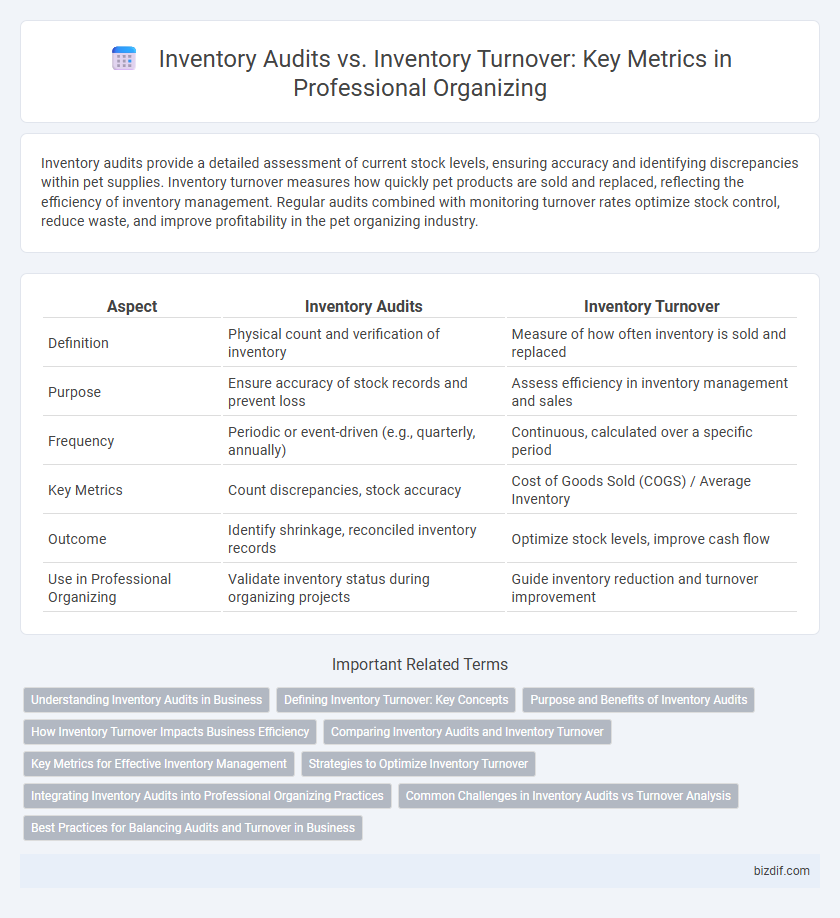Inventory audits provide a detailed assessment of current stock levels, ensuring accuracy and identifying discrepancies within pet supplies. Inventory turnover measures how quickly pet products are sold and replaced, reflecting the efficiency of inventory management. Regular audits combined with monitoring turnover rates optimize stock control, reduce waste, and improve profitability in the pet organizing industry.
Table of Comparison
| Aspect | Inventory Audits | Inventory Turnover |
|---|---|---|
| Definition | Physical count and verification of inventory | Measure of how often inventory is sold and replaced |
| Purpose | Ensure accuracy of stock records and prevent loss | Assess efficiency in inventory management and sales |
| Frequency | Periodic or event-driven (e.g., quarterly, annually) | Continuous, calculated over a specific period |
| Key Metrics | Count discrepancies, stock accuracy | Cost of Goods Sold (COGS) / Average Inventory |
| Outcome | Identify shrinkage, reconciled inventory records | Optimize stock levels, improve cash flow |
| Use in Professional Organizing | Validate inventory status during organizing projects | Guide inventory reduction and turnover improvement |
Understanding Inventory Audits in Business
Inventory audits provide a detailed assessment of stock levels and accuracy, ensuring businesses maintain precise records and identify discrepancies for effective asset management. Unlike inventory turnover, which measures how quickly inventory is sold and replaced, audits focus on verifying the physical existence and condition of items. Conducting regular inventory audits improves operational efficiency by preventing stockouts, reducing excess inventory, and enhancing financial reporting accuracy.
Defining Inventory Turnover: Key Concepts
Inventory turnover measures how often stock is sold and replaced within a specific period, reflecting a company's efficiency in managing its inventory. This metric is calculated by dividing the cost of goods sold (COGS) by the average inventory value, highlighting the velocity of inventory movement. High inventory turnover indicates effective inventory management and strong sales performance, which is crucial for professional organizing businesses aiming to minimize excess stock and optimize storage space.
Purpose and Benefits of Inventory Audits
Inventory audits serve to accurately assess and verify the actual stock levels, ensuring that financial records and physical inventory are aligned, which prevents discrepancies and potential losses. Unlike inventory turnover, which measures how quickly stock is sold and replaced, inventory audits provide a detailed snapshot of current inventory conditions, identifying obsolete or damaged items. This process enhances inventory management, improves order accuracy, and supports informed decision-making for restocking and space optimization.
How Inventory Turnover Impacts Business Efficiency
Inventory turnover measures how quickly products are sold and replaced, directly impacting cash flow and storage costs in professional organizing businesses. High inventory turnover indicates efficient use of space and resources, minimizing excess stock and reducing clutter. Regular inventory audits complement turnover analysis by ensuring accurate stock levels and identifying slow-moving items that can hinder operational efficiency.
Comparing Inventory Audits and Inventory Turnover
Inventory audits provide a detailed, periodic assessment of physical stock levels, ensuring accuracy and identifying discrepancies between recorded and actual inventory. Inventory turnover measures the rate at which inventory is sold and replaced over a specific period, indicating the efficiency of inventory management. Comparing these metrics helps professional organizers optimize stock control by balancing accuracy from audits with performance insights from turnover rates.
Key Metrics for Effective Inventory Management
Inventory audits provide a detailed assessment of stock accuracy by physically verifying quantities, ensuring data integrity for effective decision-making. Inventory turnover measures how quickly products are sold and replaced, reflecting operational efficiency and demand patterns. Monitoring both key metrics enables businesses to optimize stock levels, reduce holding costs, and improve cash flow in professional organizing environments.
Strategies to Optimize Inventory Turnover
Implementing regular inventory audits enhances accuracy in stock records, enabling precise tracking of product quantities and reducing discrepancies. Optimizing inventory turnover involves analyzing sales patterns and adjusting reorder levels to prevent overstocking or stockouts, improving cash flow and storage efficiency. Leveraging automated inventory management systems allows for real-time data insights, facilitating dynamic stock replenishment strategies that align with market demand fluctuations.
Integrating Inventory Audits into Professional Organizing Practices
Integrating inventory audits into professional organizing practices enhances accuracy in tracking household or office items, allowing organizers to identify obsolete or excess goods systematically. Inventory turnover rates provide valuable insights into how frequently items are used or replaced, guiding organizers in recommending optimal storage solutions and decluttering strategies. Combining regular inventory audits with turnover analysis elevates efficiency by aligning organizational systems with real-time usage patterns.
Common Challenges in Inventory Audits vs Turnover Analysis
Inventory audits frequently encounter challenges such as inaccurate stock counts, misplaced items, and inconsistent record-keeping, leading to discrepancies between physical and recorded inventory. Inventory turnover analysis often struggles with outdated sales data, seasonal demand fluctuations, and misaligned reorder points that can distort turnover rates. Both processes require precise data integration and regular updates to ensure accurate inventory management and optimal stock levels.
Best Practices for Balancing Audits and Turnover in Business
Regular inventory audits ensure accurate stock records, minimizing discrepancies that can harm business operations. Monitoring inventory turnover rates helps identify slow-moving items and optimize reorder schedules for improved cash flow. Balancing thorough audits with efficient turnover management enhances overall inventory control, reducing carrying costs and boosting profitability.
inventory audits vs inventory turnover Infographic

 bizdif.com
bizdif.com